[Work in progress, very wordy however given these guys practically created FPS I think it is fair.]

About
id Software is an American video game developer best known for creating titles such as Doom, Quake and Wolfenstein. id Software’s current headquarters is located in Richardson, Texas.
History
id Software was created by four members of the computer software company Softdisk, these being: John Carmack, John Romero, Tom Hall and Adrian Carmack in Mesquite, Texas, 1991. The team originally met when developing Softdisk’s monthly video game releases. After John Carmack created a 2D side-scrolling engine which could be run efficiently on computers of the time, both Carmack and Hall created a replica of the first level of Super Mario Bros 3 pasting in Romero’s “Dangerous Dave” character as a substitute for Mario. The team after seeing the potential of this engine began to use Softdisk computers to create a full port of Super Mario Bros 3 with the idea of selling it to Nintendo which subsequently failed.
Commander Keen
After this failure, the team were contacted by Scott Miller of Apogee Software who stated his desire to publish 2D side-scroller games for the PC market using the Carmack engine. With this in mind, the team created the first game in the Commander Keen series of 2D side-scrollers which Miller subsequently published.
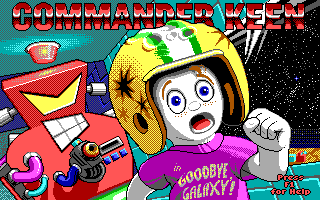
However due to Carmack, Romero and Co. using Softdisk computers behind the backs of their managers and subsequently being caught. The team was forced to sign a contract which meant they had to provide a new game to Softdisk every month as an independent company and hence the team formed id Software.
Wolfenstein
About a year after the creation of id Software, John Carmack after seeing an engine demo for the game Ultima: Underworld by Looking Glass Studios, he came up with the idea of improving and speeding up the engine’s ray casting rendering system to increase the low frame rate of the engine. Carmack was subsequently successful at building such an engine but at the cost of not having features such as lighting and height differences. However the engine could be run on even some of the lowest end PCs of the time making it very accessible.

After this engine was created, Romero and Co had the idea for reworking and rebooting the Muse Software stealth title Castle Wolfenstein. After attempts to make a stealth game in Carmack’s engine failed due to the game-play slowing down and the over complicated controls, the team decided to go all out in creating an action game which had simple controls and secrets which rewarded exploration.
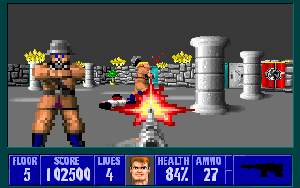
Wolfenstein 3D subsequently achieved critical acclaim and sold over 100000 copies which was unprecedented for shareware games at the time. This cemented id’s place as one for the best first person shooter developers in the gaming sphere.
Doom
After the success of Wolfenstein 3D and while Romero and Co worked on a expansion for Wolfenstein 3D, John Carmack separated himself from the team to create a new engine with multiple improvements over the Wolf 3D engine. The new “Doom Engine” added things such as Doors, Saving, Height Difference, Textured floors and Ceilings, Lighting and many more advancements over the previous engine.

The team subsequently used this engine to initially create a game with an intricate sci-fi plot inspired by the movie Aliens, however after disagreements between Hall and Carmack, Hall left id to join 3D Realms and the plot was changed to a significantly more action based and violent game.
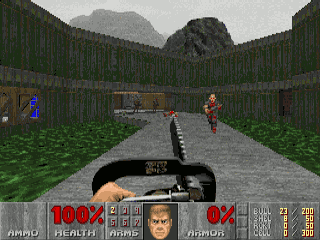
Doom was released in 1993 and was met with critical acclaim and single handedly popularised first-person shooter games the world over. Its combination of advanced graphics never seen in PC games before and its multiplayer match making made it into a global phenomenon. Almost 10 million copies were sold within 3 years of its release.
Quake
After the success of both Doom and its sequel Doom 2, Carmack sought to advance the technology which made Doom a household name. He subsequently sought to create a fully 3D engine using 3D polygons for characters over sprites and full 3D level design combined with an easier and more efficient multi-player client.
The idea for the game and its title came from a character created by id Software when working on Commander Keen. according to Carmack “Quake was the strongest, most dangerous person on the continent armed with thunderbolts and a Ring of Regeneration.” This idea transformed into a HP Lovecraft inspired setting where a lone soldier is sent through a gateway to battle creatures being sent to earth by an unknown entity codenamed Quake which he has been tasked with killing.

The game combined this setting with a soundtrack created by Trent Reznor of Nine Inch Nails to amplify Quake’s horror setting. The game eventually released to excellent reviews and is seen by most as being the genesis of today’s 3D video gaming scene as the Quake engine has spawned numerous other engines and games, most notably Valve’s GoldSrc engine for Half-Life.
Later Years and Zenimax Acquisition.
After the success of Quake 1 and 2 and the departure of John Romero to form Ion Storm (known for games such as the infamous Daikatana and the critically acclaimed Deus Ex). id Software continued to create more advanced game engines with sequels to its many franchises such as Quake 3: Arena, Return to Castle Wolfenstein and Doom 3.
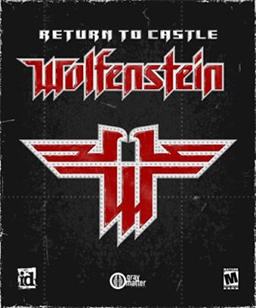
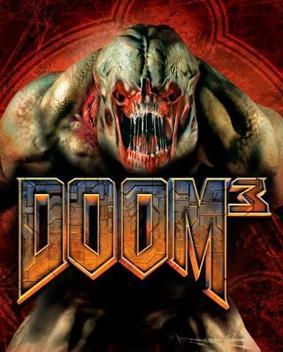
In 2009, id Software had been developing a new game with its most advanced engine to date “id Tech 5”, this game was subsequently announced as a post apocalyptic FPS called Rage. After Rage was announced, id Software was purchased by Zenimax Media (Parent company of Bethesda Softworks) with the view of id Software being another developer publishing games through Bethesda and Bethesda having access to the id Tech engines and francises.

Rage eventually released in 2011 to mixed/positive reviews, with the graphics and game-play being hailed as what id fans come to expect however the very poor performance on PCs, massive game size and poor multiplayer support caused the game to receive medium sales. After this, John Carmack, the last member of the original team still at id Software left to pursue VR with the Oculus Rift team.
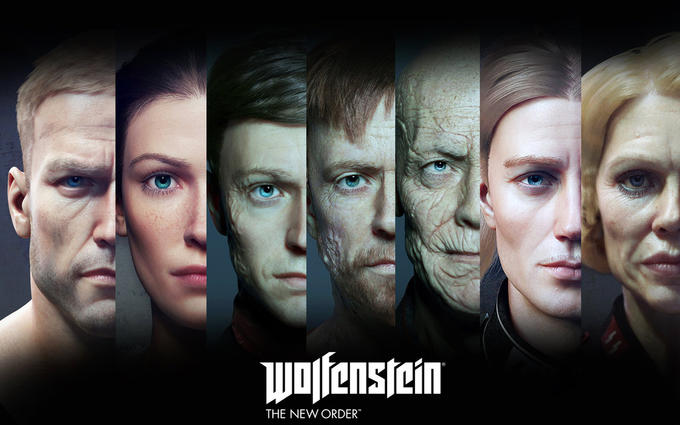
Since Carmack’s departure, Bethesda Softworks have kept id Software and their franchises going with Machine Games developing and releasing a sequel/reboot to the Wolfenstein series with Wolfenstein: The New Order. The game has been critically acclaimed due to its innovative gun play, bringing the franchise back from the dead and adding characterisation and heart to a series which typically had very little of it. Meanwhile id Software has been developing a reboot to the original Doom using its new “id Tech 666” engine.

Controversies
Wolfenstein Nazi Depictions.
After the release of Wolfenstein 3D with its use of symbols of the Nazi regime and use of the Nazi party anthem as its theme, the German government refused its release to citizens of Germany due to the use of such symbols being a federal offence in Germany when applied to Toys which video games are classed as in Germany. Despite Nazis being clearly shown as the enemy of the game, Germany and Nintendo of America refused to allow the game to sell without major censoring of the offending content.
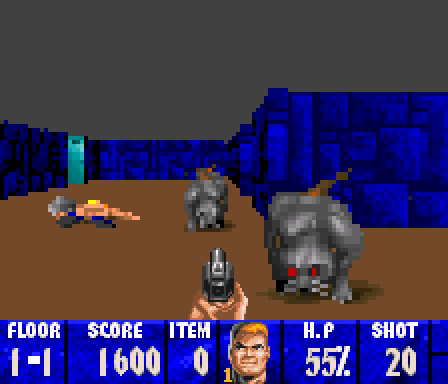
A similar outcry was brought forward by animal right groups who objected to the use of German Shepard guard dogs as enemies in the game, the fear was that such violence could cause children who play the game to harm animals in the future. In response to this, id software censored the Nintendo versions of the game while keeping the PC versions uncensored.
Doom Violence.
Due to Doom’s level of violence and use of satanic imagery due to its plot, Doom has come under considerable pressure from a number of groups and legal cases due to its perceived impact on young people and gamers.
In 1999, in the aftermath of the Columbine High School shooting, it was revealed by certain sources that both the culprits were avid video gamers with Doom being their game of choice. After fallacious details were leaked regarding one of the culprits designing a WAD map of Columbine High School and using it to prepare for the shooting, the public outcry caused Doom being discussed during a congressional hearing into the event and gave traction to a number of individuals calling for tight regulation of video games and bannings of violent games.
The Doom Violence question has since became a common focal point of discussion regarding video game violence and the crux of numerous discussions, legal hearings, studies and debates with regards to government intervention in the video game industry.
Related Memes
DopeFish
The DopeFish is a character that appeared for the first time in the video game “Commander Keen: Secret of the Oracle” in the year 1991. He became a video game industry inside joke and has many appearances in other games in the form of cameos and easter eggs.

Mein Leben!
Mein Leben! is a meme which spawned from the video game Wolfenstein 3D. When the player character encounters a Nazi SS Soldier and subsequently kills him, the soldier will shout Mein Leben as he dies (Mein Leben being the German term for “my life”). Due to comedic aspect of the phase and its overuse in the game as one of the few lines of enemy dialogue, fans started using the phase in the early days of the internet and IRC.
IDDQD
IDDQD is a cheat code used in the 1993 first person shooter game Doom, which enables a game state that prevents the player from being damaged or killed known as “god mode”. It is sometimes associated with the codes “idkfa”, which provides the player with all available weapons in the game, and “idclip”, allowing the player to pass through solid objects.
Rip and Tear / Huge Guts!
Rip and Tear / Huge Guts! is a meme which spawned from the widely panned 1996 Doom comic book where the main character Doomguy is under the influence of a berserker power up while facing a Cyberdemon leading to the popularised quote: “You are huge! That means you have huge guts! RIPANDTEAR!”. Due to the campiness of the quote and the bemused reaction from fans regarding the comic, the quote has been immortalised as the quintessential doom quote.
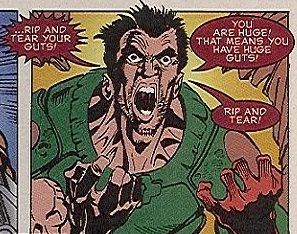
BFG 9000
The BFG 9000 is a fictional plasma weapon featured in the Doom and Quake series. Since making its first appearance in 1993, the weapon has spawned a number of reiterations in other games under the fan given nickname “Big Fucking Gun,” as well as a growing collection of fan-made replicas modeled after the original design.

Quake Done Quick
Quake Done Quick relates to one of the first instances of professional speed-running in video games. The Quake Done Quick team was comprised of gamers from the Quake community who created videos of them trying to beat the game in the quickest times possible using skills such as rocket jumping and bunny hopping. Due to the incredible times that the team and other speed-runners were achieving, this gave rise to the idea of speed running as a type of Electronic Sport with Quake being the gold standard game for all speed-runners. Other games such as Half-Life and Fallout have followed suit.

















